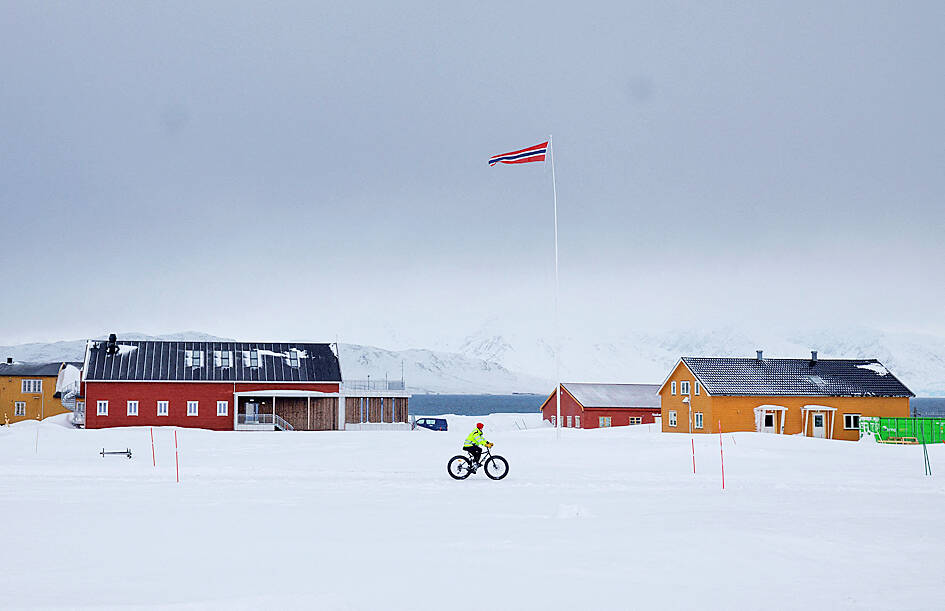The last piece of privately owned land in the strategic Svalbard archipelago in the arctic is up for grabs, a property likely to entice China, but which Norway does not intend to let go without a fight.
The archipelago is located halfway between mainland Norway and the North Pole, in an arctic region that has become a geopolitical and economic hotspot, as the ice melts and relations grow ever frostier between Russia and the West.
For 300 million euros (US$326 million), interested parties can acquire the remote Sore Fagerfjord property in southwestern Svalbard.

Photo: Reuters
Measuring 60km2 — about the size of Manhattan — the property is home to mountains, plains, a glacier and about 5km of coastline, but no infrastructure.
“It’s the last private land in Svalbard and, to our knowledge, the last private land in the world’s high arctic,” said lawyer Per Kyllingstad, who represents the sellers.
“The Chinese are naturally potential buyers since they’ve been showing a real interest in the arctic and Svalbard for a long time,” he said, adding that he had received “concrete signs of interest” from the nation.
Since China’s 2018 white paper on the arctic — a sign of its interest in the region — the nation has defined itself a “near-arctic state” and plans to play a growing role in the region.
Svalbard is governed by a 1920 international treaty that leaves ample room for foreign interests.
It recognizes Norway’s sovereignty over Svalbard, but citizens of all signatories — including China — are equally entitled to exploit the region’s natural resources.
Russia has maintained a coal mining community on Svalbard, via the state-run company Trust Arktikugol, for decades, but times have changed.
Keen to protect its sovereignty, Norway would not look kindly on the Sore Fagerfjord property falling into foreign hands.
Especially hands in China, which the Norwegian intelligence services say poses the biggest security risk to the Scandinavian nation after Russia.
The Norwegian attorney general has therefore ordered the owners — a company controlled by a Russian-born Norwegian, according to local media — to call off the planned sale.
“The land can’t be sold without the Norwegian authorities’ approval,” Norwegian Minister of Trade and Industry Cecilie Myrseth said.
“Nor is it possible to hold negotiations about the property,” she added.
That argument is based on clauses of an old loan granted by the state in 1919. Kyllingstad insists the clauses’ statute of limitations has expired.
The Norwegian state owns 99.5 percent of Svalbard and has declared most of the land, including the Sore Fagerfjord property, protected areas where construction and motorized transport, among other things, are prohibited, but the sellers do not see things that way, and cite the 1920 treaty.
“All parties [who signed the treaty] have the same rights,” Kyllingstad said, adding that Norway had built housing, an airport and a harbor in Longyearbyen, the archipelago’s main town.
“Imagine if Norway now adopted rules limiting the activities of Russian holdings,” he said. “It would be World War III.”
Andreas Osthagen of the Fridtjof Nansen research institute said that the Sore Fagerfjord land has “minimal” economic value and its possible sale does not represent “a huge threat” to Norway, but he added that “owning land on Svalbard could have a strategic value in 50 or 100 years.”
In the meantime, any mention of possible Chinese interest in Svalbard property raises “a red flag to force the Norwegian authorities to do something,” he said.
The Norwegian government in 2016 paid 33.5 million euros to acquire the second-last piece of private land on Svalbard, near Longyearbyen, which was also reportedly being eyed by Chinese investors.
Critics subsequently accused the government of being misled over unsubstantiated arguments.
In 2018 and 2019, the state had already engaged in negotiations to buy Sore Fagerfjord, but the talks collapsed over the price.
Myrseth said the option was still open if the terms were “realistic.”

PARLIAMENT CHAOS: Police forcibly removed Brazilian Deputy Glauber Braga after he called the legislation part of a ‘coup offensive’ and occupied the speaker’s chair Brazil’s lower house of Congress early yesterday approved a bill that could slash former Brazilian president Jair Bolsonaro’s prison sentence for plotting a coup, after efforts by a lawmaker to disrupt the proceedings sparked chaos in parliament. Bolsonaro has been serving a 27-year term since last month after his conviction for a scheme to stop Brazilian President Luiz Inacio Lula da Silva from taking office after the 2022 election. Lawmakers had been discussing a bill that would significantly reduce sentences for several crimes, including attempting a coup d’etat — opening up the prospect that Bolsonaro, 70, could have his sentence cut to

China yesterday held a low-key memorial ceremony for the 1937 Nanjing Massacre, with Chinese President Xi Jinping (習近平) not attending, despite a diplomatic crisis between Beijing and Tokyo over Taiwan. Beijing has raged at Tokyo since Japanese Prime Minister Sanae Takaichi last month said that a hypothetical Chinese attack on Taiwan could trigger a military response from Japan. China and Japan have long sparred over their painful history. China consistently reminds its people of the 1937 Nanjing Massacre, in which it says Japanese troops killed 300,000 people in what was then its capital. A post-World War II Allied tribunal put the death toll

A passerby could hear the cacophony from miles away in the Argentine capital, the unmistakable sound of 2,397 dogs barking — and breaking the unofficial world record for the largest-ever gathering of golden retrievers. Excitement pulsed through Bosques de Palermo, a sprawling park in Buenos Aires, as golden retriever-owners from all over Argentina transformed the park’s grassy expanse into a sea of bright yellow fur. Dog owners of all ages, their clothes covered in dog hair and stained with slobber, plopped down on picnic blankets with their beloved goldens to take in the surreal sight of so many other, exceptionally similar-looking ones.

‘UNWAVERING ALLIANCE’: The US Department of State said that China’s actions during military drills with Russia were not conducive to regional peace and stability The US on Tuesday criticized China over alleged radar deployments against Japanese military aircraft during a training exercise last week, while Tokyo and Seoul yesterday scrambled jets after Chinese and Russian military aircraft conducted joint patrols near the two countries. The incidents came after Japanese Prime Minister Sanae Takaichi triggered a dispute with Beijing last month with her remarks on how Tokyo might react to a hypothetical Chinese attack on Taiwan. “China’s actions are not conducive to regional peace and stability,” a US Department of State spokesperson said late on Tuesday, referring to the radar incident. “The US-Japan alliance is stronger and more